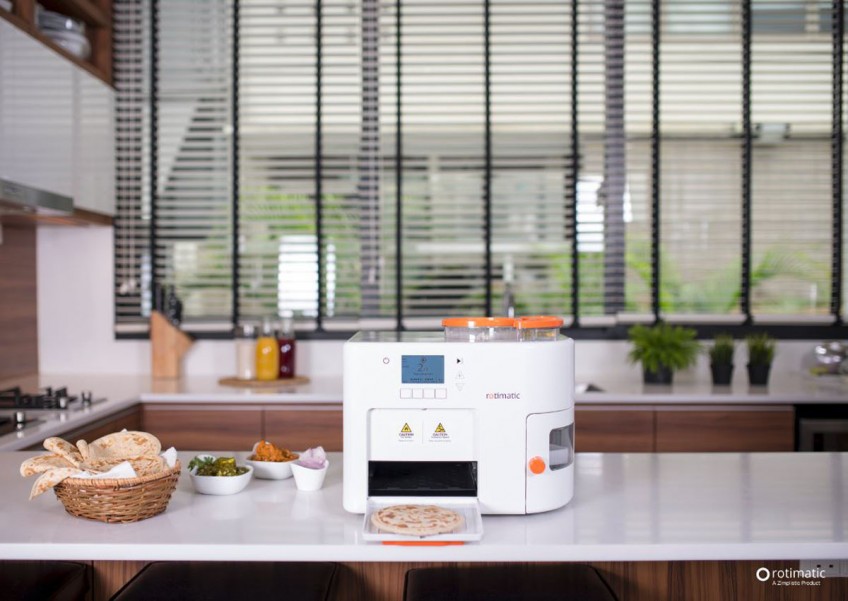5 things you didn't know about the now-famous Rotimatic

By now, many of you would have already heard about the world's first robotic chapati-maker, also known as Rotimatic, after Prime Minister Lee Hsien Loong made mention of the machine during his National Day Rally speech on Sunday.
It is a product of Zimplistic, a company that came out of Block 71 in Ayer Rajah Crescent - the heart of Singapore's entrepreneurship scene.
The company's co-founders, made up of husband-and-wife team Rishi Israni and Pranoti Nagarkar, told Mashable that the product took six years to develop.
The Rotimatic was designed to be a gamechanger and transform the way traditional Indian wholewheat flatbread is made, using patented artificial intelligence technology to measure and mix the correct ratio of flour and water.
"It is our staple diet. I thought, we washed clothes by hands, then came the washing machine. Where's the machine to make chapatis?" co-founder Ms Nagarkar, a mechanical engineer by training, told The Straits Times in an interview back in 2014.
Rotimatic was reportedly launched early last year, with an estimated 8,300 units quickly selling out within a few days.
Before you join the (extensive) waitlist, here are five things you should know about the bread-making robot:
1. It costs USD$999 (S$1,349)
The Rotimatic weighs 17kg, resembles a breadmaker, and users can customise the thickness, softness of the flatbread by following instructions on a digital panel on the device.
Those who pre-ordered the product in 2014 snagged a unit for a special price of US$599 (S$808), but otherwise, its fixed retail price is US$999.
It's a hefty price tag for sure, but judging by the response, it's not too high a price for some to pay.
The founders emphasised that the Rotimatic is intended for home use and for a family that is health-conscious (the machine only supports wheat flour) and into natural foods,this machine could probably stay with its owner for life.
2. People are losing their minds over this machine
The Rotimatic has been creating a buzz since 2014, when a four-minute YouTube video introducing the machine went viral. The clip has registered more than 4 million views to date.
But if you've been doing frantic searches on the Internet, eager to free yourself of breadmaking duties for life - we know that you probably haven't found any answer.
Rotimatic's Facebook page is pretty much flooded by frustrated users who claim that they have been waiting for this machine for years. Some even dismissed the machine as a 'scam' and others made, well, overly dramatic comments. And as usual, hilarity ensued.
3. Be prepared to wait
The Rotimatic could prove more elusive than the Yeti. Where exactly can people purchase this machine?
While there are no detailed reviews available online, it seems that people are only able to get their hands on the product after at least two years of being waitlisted.
According to lifestyle site Urbandesis, units will ship to the United States by Q4 2016, while another round of orders are being taken for Singapore residents.
For now, perhaps the only way to watch how exactly rotis are made using the Rotimatic is via this video:
[embed]https://www.youtube.com/watch?v=CBcoR8dNaOo[/embed]
4. Not just a chapati maker
As Mr Lee said during his rally speech: "Put in flour, oil and water, press a button, and out comes fresh hot chapati and roti, one per minute. If you have made chapati, you know what hard work it is."
Perhaps the hefty price tag can be due to the fact that this is no ordinary roti-making machine. Besides churning out chapatis, one could probably improvise and use the Rotimatic to make flatbreads like tortilla wraps or thin pizza bases.
Think of how much time could be saved just with this machine.
5. Rotimatic started from an initial investment of $20,000
Co-founder Ms Nagarkar spent $20,000 to create Rotimatic, and the prototype won the Start-Up Singapore competition in 2009.
The final product was launched in the market with the help of investors and Spring Singapore. The company is now worth much more, after raking in at least US$5 million in the first round of pre-orders.
ssandrea@sph.com.sg